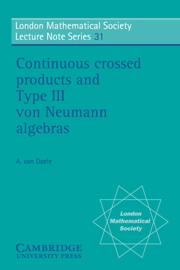Part I - Crossed products of von Neumann algebras
Published online by Cambridge University Press: 23 March 2010
Summary
INTRODUCTION
A covariant system is a triple (M, G, α) where M is a von Neumann algebra, G is a locally compact group and α is a continuous action of G on M, that is a homomorphism α : s → αs of G into the group of *-automorphisms of M such that for each X ∈ M, the map s → αs (X) s is continuous from G to M where M is considered with its strong topology. To such a covariant system is associated in a natural way a new von Neumann algebra, called the crossed product of M by the action α of G, and denoted here by M ⊗α G [16].
Similarly also covariant systems over C*-algebras are defined. In fact they have been known by mathematical physicists for some time already (see e. g. [7]). There they arise naturally because of time evolution of the physical system.
Here we will only be concerned with covariant systems over von Neumann algebras. Also they arise in a quite natural way, indeed the Tomita-Takesaki theory associates a strongly continuous one-parameter group of automorphisms to each faithful normal state on a von Neumann algebra [13, 15, 17], and clearly such a group is nothing else but a continuous action of R.
The crossed product construction can be used to provide new, more complicated examples of von Neumann algebras.
- Type
- Chapter
- Information
- Publisher: Cambridge University PressPrint publication year: 1978



